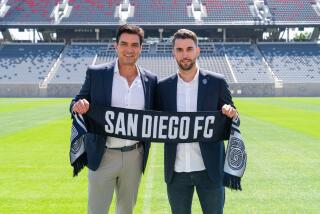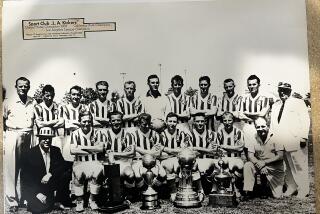Mountain of Youth
You remember Steve Sampson, the scourge of U.S. soccer. He was the coach who resigned amid a firestorm of criticism after guiding the U.S. men to their one-goal, last-place performance at the 1998 World Cup in France.
How quickly he was forgotten.
And how quickly he has rebounded.
He no longer coaches in a spotlight. But, in his role as a director of elite youth soccer programs, he might have even more influence than he did.
He is credited with, in only two years, turning around a stagnant Southern California Olympic Development Program. And, along with his teams, his stock has risen. He has been courted to coach three countries’ national teams, two Major League Soccer teams and one Division I men’s college team.
By week’s end, he must decide if he wants to coach Stanford, which has one of the nation’s most prestigious programs and was his favorite team as a youth.
“It’s flattering to have all the offers,” he said. “It shows people appreciate the job I’ve done and that I’m doing. I think the fact that I’ve stayed involved in the game and in the progress of the game has definitely worked to my advantage.”
Sampson, who played at San Jose State and led Santa Clara to an NCAA title as a coach, said all the contract details, except housing, have been settled. But because of the Bay Area’s exorbitant real-estate market, housing could be a deal breaker.
If Sampson leaves for Stanford, he won’t leave CYSA-South. He intends to commute between the two jobs. It’s not hard to see why the CYSA-South board tentatively agreed last week to let him try to juggle both for a year.
Before Sampson, Southern California’s Olympic Development Program was struggling to attract quality players, while, at the same time, battling accusations it ignored inner-city talent and allowed personal biases to play a role in the selection process.
But since Sampson took over in January 1999, he guided two state teams to victory at last year’s national tournaments, and this year saw all four teams--boys’ and girls’ leagues, ages 14 to 18--qualify for next month’s national tournament. And more Southern California players than ever are being selected for regional and national pools. The program has grown so successful, it’s now a model for the rest of the country.
“ODP was a joke, it was so political,” said Don Ebert, who runs one of the area’s top club teams, the Irvine Strikers. “At the time, I don’t think there was another person who was politically correct enough to turn it around. Steve has brought some life and honor back into the program.”
Until the Stanford job opened, Sampson was only mildly interested in one other position--head coach of the Costa Rican men’s national team.
“It was very tempting for me to take the Costa Rica job solely from the standpoint of validating my ability as a coach,” he said. “But, in the final analysis, that’s a silly reason to take a job.”
Sampson, who has lived in Agoura Hills for 10 years, also felt he owed his wife and three children stability. He had been traveling for six years in some capacity with the national team, and it was time to stay closer to home and watch Brandon, Emily and Trevor grow up.
The only coaching he does these days is for Brandon’s under-12 club team.
Brandon, 12, is a goalkeeper. Trevor, 7, is a forward who led his league in scoring with three goals a game. Emily, 10, is a center on her basketball team.
“It’s been good to reconnect with my kids,” Sampson said.
He often hears remarks about his strange career move from opposing coaches, parents and referees.
“They’ll say, ‘From the World Cup to under-12s, boy, you’ve come a long way,’ ” he said. “Or they’ll say, ‘I get to coach against Steve Sampson today.’ ”
He usually laughs. Although he takes himself as seriously as ever, he said there’s no sense being bitter about the way his three-year head coaching tenure with the U.S. national team ended.
If he were bitter, he would have left the country to coach the Costa Rican, Jamaican or Guatemalan national teams. Instead, he took a position as ODP’s technical director, helping to identify and train future players for the U.S. national team.
In a strange way, Sampson believes he has more clout now.
“This is a high-profile area,” he said. “By completely changing the identification development process for our best [youth] players, I actually have more impact on U.S. soccer.”
Changing the System
He wanted to revolutionize the training and development process nationwide while he was in charge of the U.S. national team. But he didn’t have the authority or the autonomy. Instead, he began with CYSA-South, whose history dates back more than 20 years and whose jurisdiction stretches from San Diego to San Luis Obispo.
His ambitious plan involved a year-round scouting process to find and develop Southern California players who could eventually compete for a World Cup.
It took six months of negotiations before Sampson convinced the CYSA-South board that it should dump its old system of selecting the best boys’ and girls’ players from an annual two-day tryout camp.
“If you took 300 of the best baseball players from around the country, and said ‘OK, Tommy Lasorda, you’ve got two days to decide who your best 20 players are,’ do you think you could do it? No way, but that’s exactly what happened here,” Sampson said.
That system, he said, produced one-dimensional players.
“He or she comes into this tryout, not playing the position they did with their club team, they don’t know the coach, his system or the players around him,” Sampson said.
“Everything is going against you. So what type of players do you typically get out of that environment? Players gifted on the ball, technical in nature. That’s what we had become for 15 years, a country of midfielders. No strikers, no role players and no chemistry.”
And very few lower-income players from the inner city.
Before Sampson took over, ODP cost an average family $1,500 a year for training, camp and tournament travel. Those teams, critics said, largely consisted of players whose parents made the most money and knew the most people.
“Southern California is blessed with good climate, good athletes and good coaches,” said Vince Mirabella, CYSA-South’s executive director. “But even in that view, we didn’t think we were finding the best players. Historically, we’ve had some success, but we had room to grow with perceived biases and favoritism.”
Granted a mandate for change, Sampson sought to eliminate favoritism.
He instituted a scouting system, funded in large part by a player-development grant from U.S. Soccer, designed to study players in their natural club environment, under game conditions, over an extended period. He hired a group of 40 scouts with no club affiliation to identify players.
Kevin Esparza was one of the first scouts hired. He had been an assistant coach at Chapman College and a club coach in Orange, but he left those jobs to scour the streets for talent for $100 a day.
“You’re giving up some club money to scout, but I figured here’s a chance to work for the former World Cup coach,” Esparza said. “I felt like I would be getting my master’s in coaching and meeting a lot of other talented coaches along the way. It couldn’t do anything but help my career.”
While Sampson surrounded himself with former professional players and current college coaches, he didn’t ignore club coaches. More than ever, he wanted their input and their expertise. He also wanted to hear from the coach in the recreational or unaffiliated leagues.
“There’s no way we can watch 40,000 kids play soccer in Southern California,” he said. “We have been able to identify the best leagues and, for the most part, the best teams, but we fill in the gaps by relying on coaches.
“The club coaches are the ones looking at these players day in and day out. If any coach recommends a player, we are required to go out and watch that player.”
Once scouts identify 250 players for each age group, the war-room sessions begin. After two or three long nights, twice a year, the lists are trimmed to 40 by Sampson and the scouts. After this year’s winter pool was announced, Sampson was shocked.
“Not one letter of complaint, not one e-mail,” he said. “Now for youth sports? Are you kidding me? But the reason for that is, just because you’re getting released today, doesn’t mean you can’t come back into the system the next year. We keep track of them. You can fall in favor or out of favor.”
Ebert, who played at UC Irvine and has a 15-year-old son, Eric, who plays for the Irvine Strikers, said parents had little room to complain: “As a parent, what’s your [complaint]? They’ve been watching your kid for the last eight, nine months.”
Signs of Success
Two weekends ago in Las Vegas, Sampson and his scouts reaped the rewards of their hard work. The under-16 and under-18 boys’ and girls’ state teams won a regional competition against teams from Northern California and other western states and advanced to the national ODP tournament that will be played in March. Over the last two years, CYSA-South teams have won seven of eight regional titles.
Another clear indicator of the program’s success came last year, when Southern California players took up 60% of the roster space on all eight West regional teams, ages 14-17. In the past, Southern California youths had accounted for about 35% of the roster spots.
CYSA-South teams also won national titles in the under-16 boys’ and girls’ divisions last year.
Many in the Southern California soccer community know that the success of CYSA-South will not keep Sampson satisfied forever.
“Steve’s a great guy and I don’t begrudge anybody for trying to improve their lot. He has left a definite mark on our association and he has laid the foundation,” Mirabella said.
Said Ebert: “When you’ve coached at that level, you don’t just turn it off and say I’m going to go look at 10-year-olds the rest of my life. He’s back on the world and major college scene. He is driven by that.”
Sampson doesn’t deny it.
“Coaching is in my blood and that’s what I love to do the most,” he said. “Right behind is the ability to make an impact on the future of the sport. But my ultimate goal is to finish the business that was left behind in France. Before my career is over, I would like another shot at it.”
Even though Sampson was the first American-born coach to help the U.S. qualify for a World Cup in 1998, and he still has the highest international winning percentage (.558) of any U.S. national team in the 83-year history of U.S. soccer, he understands that people won’t forget France.
But he would like to believe it was more than a once-in-a-lifetime opportunity.
“The time will come when I have an opportunity again,” he said. “There are only a few people in the world that have the experience that I do, and there are only a couple in this country. At some point, I will put that experience to use again.”
(BEGIN TEXT OF INFOBOX / INFOGRAPHIC)
Goal Oriented
In the last year, Southern California youth teams directed by Steve Sampson have won seven of a possible eight regional championships and two national championships--with the possibility of four more:
2000
Boys under-18--Did not advance out of regional.
Girls under-18--Lost in the national championship game, 1-0.
Boys under-16--Won the national championship.
Girls under-16--Won the national championship.
2001
Boys under-18--Won regional and advanced to national
championship in March.
Girls under-18--Won regional and advanced to national
championship in March.
Boys under-16--Won regional and advanced to national
championship in March.
Girls under-16--Won regional and advanced to national
championship in March.







